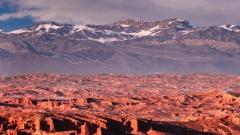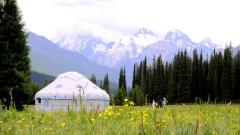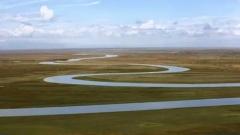The Silk Road is more than a route — it’s a bridge between civilizations, a living story of trade, art, and adventure that shaped the world. Among its many branches, the stretch from Dunhuang to Kashgar is perhaps the most evocative, passing through deserts, mountains, and oases that once guided merchants and monks across ancient Asia.
Today, travelers can retrace this legendary route across northwestern China, following in the footsteps of explorers like Marco Polo and Xuanzang. From Buddhist caves to Uyghur bazaars, the journey reveals the cultural heartbeat of China’s western frontier.
1. Dunhuang: The Desert Gateway of Buddhist Art
Your Silk Road adventure begins in Dunhuang, a desert oasis in Gansu Province, once the last stop before caravans entered the vast Taklamakan Desert.
Must-See Attractions:
-
Mogao Caves: A UNESCO World Heritage Site with over 700 caves filled with exquisite Buddhist murals and sculptures dating back 1,500 years.
-
Crescent Lake & Singing Sand Dunes: A surreal landscape where golden dunes meet a crescent-shaped oasis. You can ride camels, sandboard, or watch the sunset over the desert.
-
Shazhou Night Market: Taste hand-pulled noodles, grilled lamb skewers, and local dried fruits — echoes of the flavors that once fueled ancient traders.
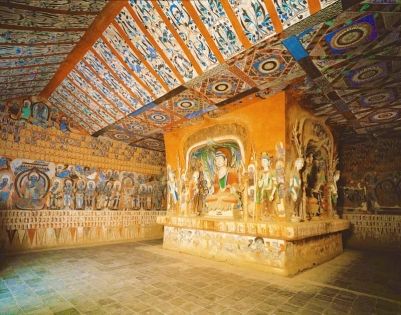
Mogao Caves
Travel Tip: Spend at least two nights here. For photographers, sunrise and sunset bring perfect lighting on the dunes.
2. Jiayuguan: The Western End of the Great Wall
Leaving Dunhuang, the road heads west to Jiayuguan, known as the “First and Last Fortress Under Heaven.”
Highlights:
-
Jiayuguan Fortress: Built during the Ming Dynasty, this fortress marks the traditional western end of the Great Wall. Its ramparts and watchtowers overlook the Gobi Desert.
-
Overhanging Great Wall: A steep section of wall climbing up the cliffs — great for panoramic photos.
-
Museum of the Great Wall: Learn how the fortress served as a checkpoint for Silk Road traders and soldiers.
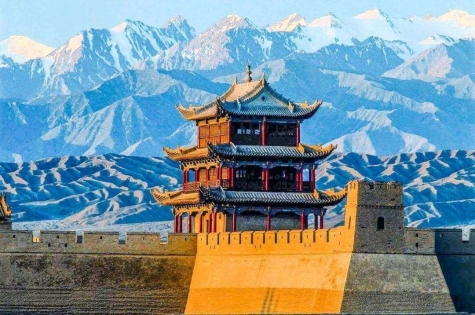
Jiayuguan
Tip: Jiayuguan is best explored on a clear day, when the fortress stands sharply against the backdrop of snow-capped Qilian Mountains.
3. Turpan: Oasis of Grapes and Ancient Ruins
Next, take a train or drive to Turpan in Xinjiang, an ancient oasis city surrounded by desert and vineyards. Despite its scorching summer heat, Turpan has flourished for millennia thanks to its ingenious underground irrigation system, the Karez.
Top Attractions:
-
Jiaohe Ancient City: A 2,000-year-old mud-brick city carved from a river plateau — one of the best-preserved ancient ruins in China.
-
Emin Minaret: A striking 18th-century mosque with intricate brickwork and Central Asian design.
-
Flaming Mountains: Red sandstone cliffs that glow like fire at sunset — a must-see for photographers.
-
Karez Wells: Explore the ancient engineering system that brought water from the Tianshan Mountains to this arid land.
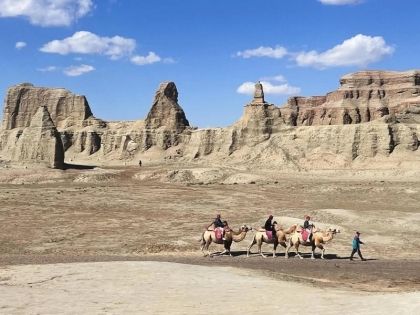
Jiaohe Ancient City
Local Experience: Visit a local Uyghur family to taste sweet Turpan raisins and grapes, and listen to folk music that’s been passed down for centuries.
4. Korla and the Tianshan Mountains
From Turpan, continue west toward Korla, known as the “Pearl of the Desert.” It sits at the foot of the Tianshan Mountains, offering a refreshing mix of desert and river scenery.
Things to Do:
-
Walk along the Kongque River, especially at night when the bridges and waterfront glow under colorful lights.
-
Visit the Iron Gate Pass, a narrow gorge that once controlled Silk Road access.
-
Try the Korla fragrant pear, famous across China for its sweetness.
Adventure Option: Travelers with more time can detour north through Bayingolin Grasslands for stunning views of snow peaks and yurts.
5. Kuqa: The Ancient Buddhist Kingdom
Westward lies Kuqa (Kucha), once a thriving Buddhist kingdom and one of the most important cultural centers on the Silk Road.
Cultural Highlights:
-
Kizil Thousand Buddha Caves: Older than Dunhuang’s Mogao Caves, these grottoes showcase early Buddhist art with Central Asian influences.
-
Grand Mosque of Kuqa: A fine example of Islamic architecture blending local and Persian styles.
-
Subashi Ruins: Remains of a vast Buddhist monastery complex, offering a glimpse into Kuqa’s spiritual past.

Kizil Thousand Buddha Caves
Insider Tip: Kuqa is a perfect stop for those interested in ancient Buddhist art and cultural blending between India, Persia, and China.
6. Aksu to Kashgar: Through the Heart of the Silk Road
The final stretch from Aksu to Kashgar runs along the northern rim of the Taklamakan Desert. The scenery alternates between barren dunes and green oases fed by mountain rivers.
Aksu Highlights:
-
Tianshan Grand Canyon (Aksu Canyon): Red cliffs, winding valleys, and dramatic shadows — ideal for adventure photography.
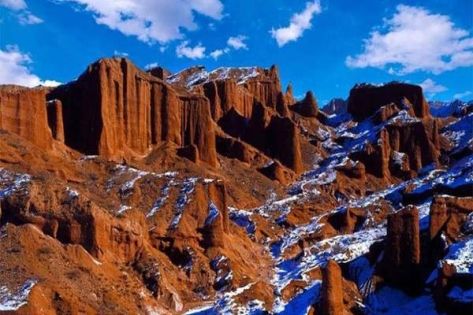
Tianshan Grand Canyon
Then, after hours of desert highway, you’ll reach the legendary city of Kashgar — the crown jewel of the Silk Road.
7. Kashgar: The Crossroads of Cultures
Kashgar, in far western Xinjiang, is where the ancient East met the Islamic West. Its old town still hums with the sounds and scents of centuries-old trade.
Must-Experience Highlights:
-
Id Kah Mosque: The largest mosque in China and the spiritual heart of Uyghur Islam.
-
Kashgar Old Town: Wander narrow lanes lined with traditional mud-brick homes, artisans’ workshops, and teahouses.
-
Sunday Livestock Market: A sensory explosion of bargaining, livestock trading, and local snacks — unchanged for generations.
-
Apak Hoja Tomb: A beautiful Islamic mausoleum with a turquoise-tiled dome, an architectural gem.
Cultural Tip: Dress modestly when visiting religious sites, and always ask permission before photographing locals.
8. Route Overview & Travel Tips
| Section | Highlights | Distance | Recommended Duration |
|---|---|---|---|
| Dunhuang → Jiayuguan | Desert art, Great Wall | 380 km | 2–3 days |
| Jiayuguan → Turpan | Desert drive | 600 km | 2 days |
| Turpan → Korla | Oasis landscapes | 350 km | 1–2 days |
| Korla → Kuqa | Tianshan views | 280 km | 2 days |
| Kuqa → Aksu | Canyons, ruins | 300 km | 1–2 days |
| Aksu → Kashgar | Desert + oasis | 500 km | 2–3 days |
When to Go
-
Best Months: April–June, September–October
-
Avoid: July–August (very hot), December–February (some regions closed due to snow)
Transportation Options
-
Train: The new Lanzhou–Urumqi–Kashgar high-speed line connects most cities.
-
Car: Perfect for those who want freedom to stop at small villages and scenic spots.
-
Guided Tours: Ideal for foreign travelers needing permits and translation support.
Conclusion
From the ancient murals of Dunhuang to the bustling bazaars of Kashgar, this Silk Road journey is a living museum of humanity’s shared past. Every stop along the way reveals a different layer of culture — Buddhist, Islamic, Chinese, and Central Asian — all woven together by centuries of exchange.
Traveling this route today is not just about seeing monuments, but about experiencing the spirit of the Silk Road itself — endurance, diversity, and wonder.
For more Silk Road and Western China travel routes, visit our official website China Dragon Travel for inspiration and guided tours.



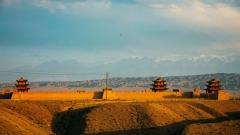

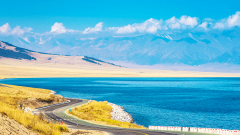
![11 Day Tour[Winter Limited] Drunken Beauty Xinjiang Ice and Snow Kanas Fairy Tale New Vision](https://www.chinadragontravel.com/wp-content/uploads/2025/12/25cff76cef9e445-240x135.jpg)
